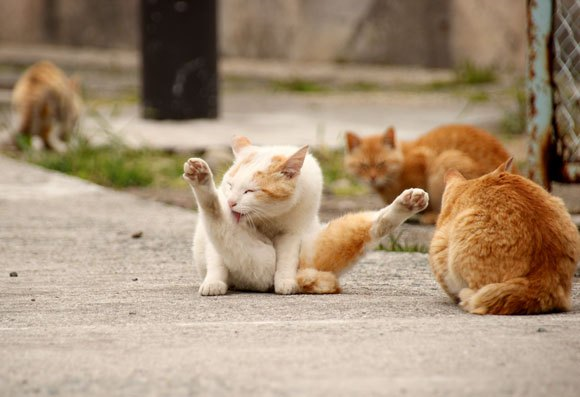
Aging, shrinking human population says it can no longer take care of all of the frisky felines.
The island of Aoshima, part of Japan’s Ehime Prefecture, is commonly considered a feline paradise. While it’s not Japan’s only cat island, it’s the most famous, attracting visitors both domestic and international who come to see the 130 kitties that roam free along the streets of the island community.
Walking around Aoshima, you’ll see sights like this…
…this…
…and…
…wow, that’s really a lot of cats, isn’t it? As a matter of fact, Aoshima’s residents feel they’ve finally reached the point of having too many cats. While the animals can wander about wherever they please, they’re largely taken care of by the Aoshima Cat Protection Society, which has recommended that all of the cats on the island be spayed or neutered in order to gradually reduce their population.
In contrast to the 130 cats that live on the island, there are only 13 human residents, with an average age of over 75 years old. Those demographics are up about 30 cats and down two humans since four years ago, and a lack of people, as well as infrastructure, has the society thinking it can’t reasonably sustain any larger number of felines than Aoshima currently has. In 2016, the organization even had to solicit donations of cat food to keep the animals fed.
The Aoshima Cat Protection Society recommended a spaying/neutering initiative last July, and the city has now earmarked funds for such a program in its preliminary budget proposal for the upcoming fiscal year. Working with Hyogo-based animal welfare organization Dobutsu Kikin, the plan would have veterinarians travel to Aoshima and remain on the island while the procedures are carried out, which would require roughly 400,000 yen (US$3,640) in travel and lodging expenses.
▼ The town is OK with kitty love, just not any more kitty babies.
While Aoshima’s cat island cachet has made it a popular tourism destination, the almost complete lack of commerce on the island (it doesn’t have even a single vending machine, a shocking status for a Japanese town) means that the influx of visitors isn’t accompanied by an influx of revenue, so it’s unlikely there’s enough money in the city’s coffers to simply expand the services/facilities of the Aoshima Cat Protection Society. Plus, while the cats are provided food by the society, their ability to go where they please throughout the island means that in many ways they’re like a pack of strays, and allowing their number to go completely unchecked could lead to hygienic or other issues.
A timetable for the proposed program is yet to be set, but the Japanese fiscal year begins in the spring, so if the initiative is ultimately approved, operations would likely begin soon after.
Source: Yahoo! Japan News/Ehime Shimbun Online via Jin
Photos ©SoraNews24

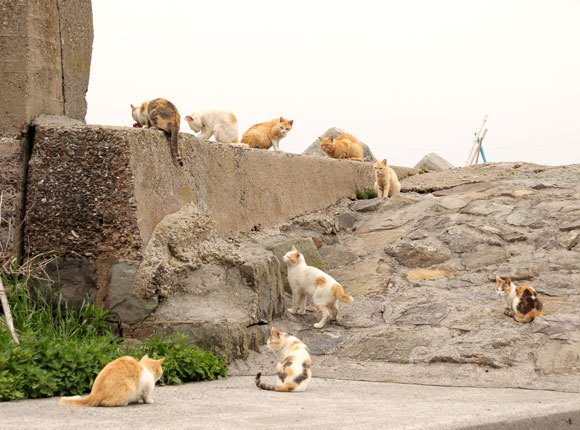
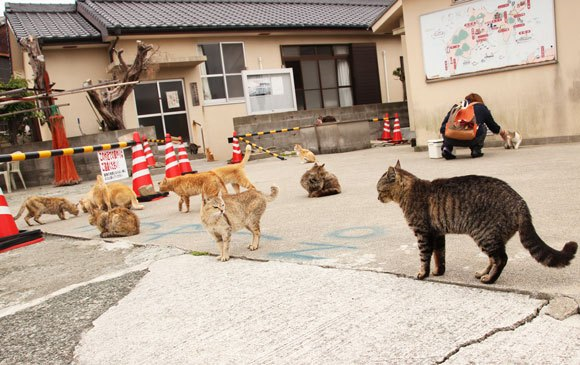
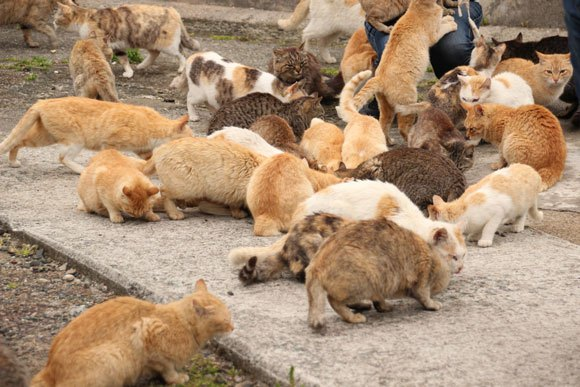
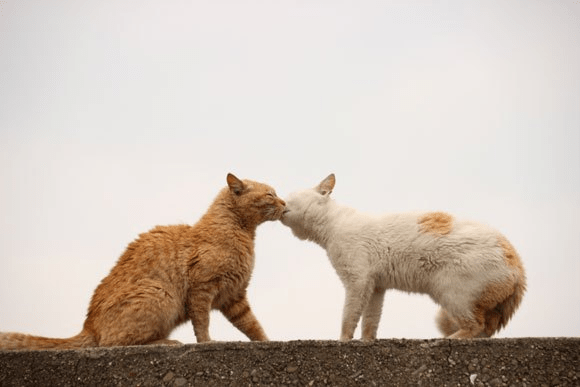
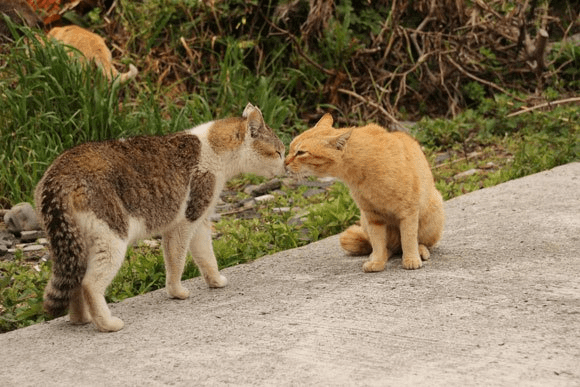
 Aoshima Island has 100 cats, and we photographed almost all of them
Aoshima Island has 100 cats, and we photographed almost all of them Is Japan’s Cat Island in danger of turning into the Island of Fat Cats?
Is Japan’s Cat Island in danger of turning into the Island of Fat Cats? Creating a cat island – Japanese organization plans to buy island turn it into kitty paradise
Creating a cat island – Japanese organization plans to buy island turn it into kitty paradise Japan’s Cat Island tweets a plea for cat food, gets so much they can barely store it all
Japan’s Cat Island tweets a plea for cat food, gets so much they can barely store it all A shocking discovery in Sapporo as 238 cats are found living under one roof in dismal conditions
A shocking discovery in Sapporo as 238 cats are found living under one roof in dismal conditions McDonald’s new Happy Meals offer up cute and practical Sanrio lifestyle goods
McDonald’s new Happy Meals offer up cute and practical Sanrio lifestyle goods All-you-can-drink Starbucks and amazing views part of Tokyo’s new 170 meter-high sky lounge
All-you-can-drink Starbucks and amazing views part of Tokyo’s new 170 meter-high sky lounge Studio Ghibli glasses cases let anime characters keep an eye on your spectacles
Studio Ghibli glasses cases let anime characters keep an eye on your spectacles More foreign tourists than ever before in history visited Japan last month
More foreign tourists than ever before in history visited Japan last month Super Nintendo World expansion gets delayed for several months at Universal Studios Japan
Super Nintendo World expansion gets delayed for several months at Universal Studios Japan Starbucks reopens at Shibuya Scramble Crossing with new look and design concept
Starbucks reopens at Shibuya Scramble Crossing with new look and design concept Kyoto’s 100 Demons yokai monster parade returns!
Kyoto’s 100 Demons yokai monster parade returns! There’s a park inside Japan where you can also see Japan inside the park
There’s a park inside Japan where you can also see Japan inside the park Still don’t want a smartphone? Japanese women might want you
Still don’t want a smartphone? Japanese women might want you Korean tattoo artist’s small, simple, stylish “line tattoos” change our impression of getting inked
Korean tattoo artist’s small, simple, stylish “line tattoos” change our impression of getting inked Disney princesses get official manga makeovers for Manga Princess Cafe opening in Tokyo
Disney princesses get official manga makeovers for Manga Princess Cafe opening in Tokyo Beautiful new Final Fantasy T-shirt collection on the way from Uniqlo【Photos】
Beautiful new Final Fantasy T-shirt collection on the way from Uniqlo【Photos】 Is the new Shinkansen Train Desk ticket worth it?
Is the new Shinkansen Train Desk ticket worth it? Foreign English teachers in Japan pick their favorite Japanese-language phrases【Survey】
Foreign English teachers in Japan pick their favorite Japanese-language phrases【Survey】 Japanese convenience store packs a whole bento into an onigiri rice ball
Japanese convenience store packs a whole bento into an onigiri rice ball We try out “Chan Ramen”, an underground type of ramen popular in the ramen community
We try out “Chan Ramen”, an underground type of ramen popular in the ramen community Studio Ghibli releases Kiki’s Delivery Service chocolate cake pouches in Japan
Studio Ghibli releases Kiki’s Delivery Service chocolate cake pouches in Japan Japan’s bone-breaking and record-breaking roller coaster is permanently shutting down
Japan’s bone-breaking and record-breaking roller coaster is permanently shutting down New definition of “Japanese whiskey” goes into effect to prevent fakes from fooling overseas buyers
New definition of “Japanese whiskey” goes into effect to prevent fakes from fooling overseas buyers Our Japanese reporter visits Costco in the U.S., finds super American and very Japanese things
Our Japanese reporter visits Costco in the U.S., finds super American and very Japanese things Studio Ghibli unveils Mother’s Day gift set that captures the love in My Neighbour Totoro
Studio Ghibli unveils Mother’s Day gift set that captures the love in My Neighbour Totoro Foreign passenger shoves conductor on one of the last full runs for Japan’s Thunderbird train
Foreign passenger shoves conductor on one of the last full runs for Japan’s Thunderbird train Domino’s Japan now sells…pizza ears?
Domino’s Japan now sells…pizza ears? New Japanese KitKat flavour stars Sanrio characters, including Hello Kitty
New Japanese KitKat flavour stars Sanrio characters, including Hello Kitty Kyoto creates new for-tourist buses to address overtourism with higher prices, faster rides
Kyoto creates new for-tourist buses to address overtourism with higher prices, faster rides Sales of Japan’s most convenient train ticket/shopping payment cards suspended indefinitely
Sales of Japan’s most convenient train ticket/shopping payment cards suspended indefinitely Sold-out Studio Ghibli desktop humidifiers are back so Totoro can help you through the dry season
Sold-out Studio Ghibli desktop humidifiers are back so Totoro can help you through the dry season Japanese government to make first change to romanization spelling rules since the 1950s
Japanese government to make first change to romanization spelling rules since the 1950s Ghibli founders Toshio Suzuki and Hayao Miyazaki contribute to Japanese whisky Totoro label design
Ghibli founders Toshio Suzuki and Hayao Miyazaki contribute to Japanese whisky Totoro label design Doraemon found buried at sea as scene from 1993 anime becomes real life【Photos】
Doraemon found buried at sea as scene from 1993 anime becomes real life【Photos】 Tokyo’s most famous Starbucks is closed
Tokyo’s most famous Starbucks is closed One Piece characters’ nationalities revealed, but fans have mixed opinions
One Piece characters’ nationalities revealed, but fans have mixed opinions We asked a Uniqlo employee what four things we should buy and their suggestions didn’t disappoint
We asked a Uniqlo employee what four things we should buy and their suggestions didn’t disappoint Princesses, fruits, and blacksmiths: Study reveals the 30 most unusual family names in Japan
Princesses, fruits, and blacksmiths: Study reveals the 30 most unusual family names in Japan Turn your kitty into a Japanese sweet with Felissimo’s new Anmitsu Nyanko Cushion cat bed
Turn your kitty into a Japanese sweet with Felissimo’s new Anmitsu Nyanko Cushion cat bed Ed Sheeran invited to visit cat island in Japan with video from Japanese town
Ed Sheeran invited to visit cat island in Japan with video from Japanese town “Cat shrine” status causing problems for Japan’s millennium-old Izumoiwai Shrine
“Cat shrine” status causing problems for Japan’s millennium-old Izumoiwai Shrine Who needs pre-furnished apartments when you can get one that comes with a cat?
Who needs pre-furnished apartments when you can get one that comes with a cat? Twitter user posts video of swarming bunnies on Rabbit Island, we all wish we were there
Twitter user posts video of swarming bunnies on Rabbit Island, we all wish we were there Pet your cat and remain effortlessly stylish with this fur-resistant coat
Pet your cat and remain effortlessly stylish with this fur-resistant coat You can find the happiest pigs in the world on “Pig Island”, and swim with them too!【Photos】
You can find the happiest pigs in the world on “Pig Island”, and swim with them too!【Photos】 Japanese kitty picks a crazy spot for its daily catnap, becomes local celebrity【Video, photos】
Japanese kitty picks a crazy spot for its daily catnap, becomes local celebrity【Video, photos】 Japan has a cat real estate agency, where every apartment lets you and your kitty live together!
Japan has a cat real estate agency, where every apartment lets you and your kitty live together! 【PSA】Knock knock! Check your car, save a cat
【PSA】Knock knock! Check your car, save a cat Japan’s awesomely adorable cat pseudo-currency is actually usable at one very special place【Pics】
Japan’s awesomely adorable cat pseudo-currency is actually usable at one very special place【Pics】 The secret to making cats love you: This one brand of Japanese jeans, believers say
The secret to making cats love you: This one brand of Japanese jeans, believers say Automatic cat feeder is no match for this clever kitty【Video】
Automatic cat feeder is no match for this clever kitty【Video】 Young and elderly alike can satisfy their feline frenzy with this $180 cat robot companion
Young and elderly alike can satisfy their feline frenzy with this $180 cat robot companion
Leave a Reply